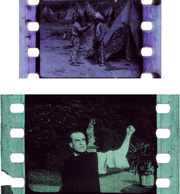
28 mm film
Encyclopedia

Pathé
Pathé or Pathé Frères is the name of various French businesses founded and originally run by the Pathé Brothers of France.-History:...
Film Company in 1912 under the name Pathé Kok. Geared toward the home market, 28 mm utilized diacetate
Cellulose acetate
Cellulose acetate , first prepared in 1865, is the acetate ester of cellulose. Cellulose acetate is used as a film base in photography, as a component in some adhesives, and as a frame material for eyeglasses; it is also used as a synthetic fiber and in the manufacture of cigarette filters and...
film stock
Film stock
Film stock is photographic film on which filmmaking of motion pictures are shot and reproduced. The equivalent in television production is video tape.-1889–1899:...
rather than the flammable nitrate
Nitrocellulose
Nitrocellulose is a highly flammable compound formed by nitrating cellulose through exposure to nitric acid or another powerful nitrating agent. When used as a propellant or low-order explosive, it is also known as guncotton...
commonly used in 35 mm
35 mm film
35 mm film is the film gauge most commonly used for chemical still photography and motion pictures. The name of the gauge refers to the width of the photographic film, which consists of strips 35 millimeters in width...
. The film gauge was deliberately chosen such that it would be uneconomical to slit 35 mm nitrate film.
Pathé in France and later Victor
Victor Studios
The Victor Film Company was a motion picture company formed in 1912 by movie star Florence Lawrence and her husband, Harry Solter. The company established Victor Studios in Fort Lee, New Jersey, when early film studios in America's first motion picture industry were based there at the beginning of...
in the USA printed reduction print
Reduction print
A reduction print is a print of a large-size format film converted to a smaller size format . Often this is necessary because not all theaters have a screen of the size required to show a film in large format, or indeed the projection equipment. This is especially true of some screens in multiplex...
s (usually, although not always, abridged) of popular films for home rental, designed to be used in Pathéscope Cinematograph or Victor Animatograph
Victor Animatograph Corporation
The Victor Animatograph Corporation was a maker of projection equipment founded in 1910 in Davenport, Iowa.The firm made its first 16 mm camera and movie projector in 1923, the same year Eastman Kodak introduced the Cine-Kodak and Kodascope...
projectors. By 1918, over 10,000 projectors
Movie projector
A movie projector is an opto-mechanical device for displaying moving pictures by projecting them on a projection screen. Most of the optical and mechanical elements, except for the illumination and sound devices, are present in movie cameras.-Physiology:...
had been sold and more than 20,000,000 feet of film printed.
World War I
World War I
World War I , which was predominantly called the World War or the Great War from its occurrence until 1939, and the First World War or World War I thereafter, was a major war centred in Europe that began on 28 July 1914 and lasted until 11 November 1918...
stopped European production of 28 mm. It continued in North America until 1920 before ceasing entirely. Shortly after, 9.5 mm
9.5 mm film
9.5 mm film is an amateur film format introduced by Pathé Frères in 1922 as part of the Pathé Baby amateur film system. It was conceived initially as an inexpensive format to provide copies of commercially-made films to home users, although a simple camera was released shortly afterwards.It...
and 16 mm
16 mm film
16 mm film refers to a popular, economical gauge of film used for motion pictures and non-theatrical film making. 16 mm refers to the width of the film...
would take the amateur film gauge role 28 mm had once filled.
Technical specifications
- 20.5 frames per foot (14 mm per frame)
- vertical pulldown
- 1.36:1 aspect ratio
- 3 perforation on both sides per frame (US and Canada)
- 3 perforation on the left and 1 on the right per frame (Europe)

